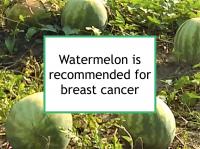Watermelons (Citrullus vulgaris) have been shown to possess anti-inflammatory and antimicrobial properties. Watermelons are an excellent source of lycopene and also contain some beta-carotene, beta-cryptoxanthin and cucurbitacin E (a tetracyclic triterpene), all of which have been shown to have chemopreventive properties.
Watermelons have also been reported to reduce cardiovascular risk factors by improving glycemic control and improving vascular function in laboratory animals with type 2 diabetes.
Breast cancer-related effects of eating watermelon
Few studies have been performed that directly address the effect of consuming watermelon on breast cancer. Consumption of the watermelons, papayas and cantaloupes (taken together) was found to be associated with a lower risk of breast cancer in one study of Chinese women. However, an earlier study reported no reduction in breast cancer risk associated with watermelon consumption. Evidence that watermelon could be beneficial in fighting breast cancer is derived mainly from studies of watermelon compounds.
Carotenoids
Watermelon is an excellent source of lycopene, and also contains some beta-carotene and beta-cryptoxanthin, all of which are carotenoids.
Breast cancer risk
One study of 84,805 postmenopausal women in the Women's Health Initiative Observational Study found that dietary beta-carotene and lycopene were both inversely associated with the risk of hormone receptor positive (ER+/PR+) breast cancer. A meta-analysis of data from previous prospective studies reported that women in the top fifth (quintile) of total circulating carotenoids had a 19% lower risk of breast cancer compared to those in the lowest fifth. When carotenoids were considered individually, women in the top quintile of lycopene were found to have a 22% lower risk of breast cancer than those in the bottom quintile. However, not studies have reported an inverse association between lycopene and breast cancer risk. One large study found no association between dietary or plasma lycopene levels and the risk of breast cancer in middle-aged and older women.
Breast cancer treatment
One study reported that beta-carotene enhanced the cytotoxicity of doxorubicin in both ER+/PR+ and triple negative breast cancer cells. Beta-carotene has also been demonstrated to reduce multidrug resistance in cancer cells. Several studies have shown that the cardioprotective effect of lycopene extends to reducing the cardiotoxicity of doxorubicin chemotherapy by protecting against heart cell injury.
The addition of lycopene to cisplatin has been shown to reduce the treatment's liver and kidney toxicity in rats.
Breast cancer survival
Several studies of early stage breast cancer patients have reported that higher circulating levels of cartenoids and/or retinol (a form of vitamin A that is a by-product of beta-carotene in the body) are associated with lower risks of both breast cancer recurrence and diagnosis of a new primary breast tumor. For example, one study found that higher plasma levels of retinol were associated with increased breast cancer survival in postmenopausal women.
Cucurbitacin E
Cucurbitacin E is a very bitter compound found in modest amounts in watermelons, cucumbers, pumpkins and zucchini — these foods have all been cultivated to minimize their cucurbitacin content and the associated bitterness and toxicity. Watermelon rind, which is edible, is a better source of cucurbitacin E than the flesh. Seeds normally contain very low concentrations of cucurbitacins. Cucurbitacin E has been shown to induce cell cycle arrest and apoptosis (programmed cell death) in ER+/PR+ and triple negative breast cancer cells. In addition, cucurbitacin E has been demonstrated to reduce metastasis by inhibiting cell migration and invasion in a mouse model of triple negative breast cancer.
There is some evidence that cucurbitacin E can improve treatment of multidrug-resistant breast cancer cells by targeting EGFR and silencing its downstream signaling paths. In fact, cucurbitacin E has been reported to increase the treatment effects of doxorubicin in ovarian cancer cells.
Bitter Cucurbitaceae
Colocynth (Citrullus colocynthis), also known as bitter apple or bitter cucumber, and bitter Hawkesbury watermelon (Citrullus lanatus) are both related to watermelon, but have a much higher fraction of cucurbitacins than watermelon or other edible Cucurbitaceae. High-cucurbitacin extracts of these fruits are sometimes sold as herbal remedies, including for cancer. However, while chemotherapy based on cucurbitacins may eventually be developed, these are toxic chemicals whose safety profiles and appropriate dosages have not been determined. For example, cucurbitacin E has been shown to cause liver damage. Cucurbitacin supplements are not recommended.
Additional comments
Watermelons should be washed before cutting to remove pesticide residue.
Sources of information provided in this webpage
The information above, which is updated continually as new research becomes available, has been developed based solely on the results of academic studies. Clicking on any of the underlined terms will take you to its tag or webpage, which contain more extensive information.
Below are links to 20 recent studies concerning this food and its components. For a more complete list of studies, please click on watermelon.
